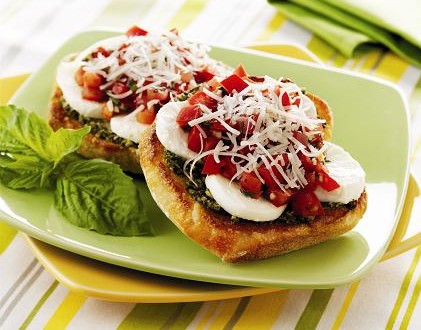Use Cheese to Your Healthy Advantage
30 January 2010Courtesy of Wisconsin Milk Marketing Board
 Deadline for a new CAFÉ recipe contest featuring Wisconsin cheeses in healthful applications is April 1.
Deadline for a new CAFÉ recipe contest featuring Wisconsin cheeses in healthful applications is April 1.
In our world of an overwhelming amount of information, some of us still don't have the right information! Such is the case among some culinary professionals and consumers when it comes to cheese and its healthfulness. Current food-trend information points to a high interest in healthfulness and well-being, a trend that many chefs are anxious to heed, so it's important to know the facts.
To put a misinformed rumor to rest, cheese is not a no-no in healthy diets—it absolutely can be part of a healthy diet, and not just reduced-fat styles, but the types of cheese restaurant patrons love—mozzarella, cheddar, Parmesan, blue and fontina, for example. Using cheese in moderation and choosing appropriate applications are the keys to keeping the succulent flavor of cheese on the menu while offering choices that fit with today's health-conscious diner.
For starters, not all cheeses are created equal when it comes to fat content and calories. As a rule of thumb, soft (high moisture) cheeses such as feta and queso blanco/fresco contain fewer calories per ounce than hard cheeses. Some cheeses are made with nonfat milk as well as whole milk. Part-skim mozzarella (the most common type at consumer level) contains about 72 calories per ounce compared to cheddar at 106 per ounce. It's easy to go online and find cheese nutritionals on a number of sites—so check them out.
In your menu applications, consider using shredded or grated cheeses. This cut not only melts beautifully, you can use less of it and still achieve a great cheesy effect. (1 cup shredded cheese generally equals about 4 ounces). Be sure to shred the cheese when it's cold for easier and quicker handling if you are not purchasing shredded varieties.
Use bold cheeses with big flavors—a little will go a long way to enhance your dish. Not only this, but trends also tell us diners prefer bigger, bolder flavors, so this type will be a menu winner, as well. Choose well-aged cheeses such as Parmesan, washed-rind cheeses such as Gruyère, soft-ripened cheeses such as Brie, and blue styles when it comes to big flavors. Or go with an assertive-flavored cheese, such as a Jack with pesto or piquant chiles such as habanero or chipotle. All of these varieties are made in Wisconsin.
Next, use cheeses with other foods that fit the health advice diners are receiving. Grate Asiago over whole-wheat pasta, use shredded flavored cheeses such as pepper Jack on a sandwich made with whole-grain bread, sprinkle Gruyère shreds over a warming cup of a broth-based soup, finish off bitter greens and other vitamin-rich vegetables with a light cheese topping, and enhance a fresh-fruit parfait with crumbles of queso blanco or fresco with a dash of juice or liqueur.
And don't believe another rumor—that cheese and fish don't “go together.” What could be better than a fresh tuna melt? Think about using cheeses with “light” center-of-the plate entrées to keep calories down and flavor high. Or, think of a cheese and fiber-rich beans or legume dish as center of plate. How about vegetarian “cassoulet”?
With more than 600 varieties, types and styles of cheese to their credit, Wisconsin cheesemakers are always trying to keep current with consumer and foodservice trends, and updating trend and nutritional information is important at Wisconsin Milk Marketing Board. Cheese contains both protein and calcium, and contains good amounts of zinc, vitamin A, vitamin B12 and phosphorous. A growing body of scientific research confirms that eating three servings of milk, cheese or yogurt each day as part of a nutritious, balanced diet may even help maintain a healthy weight. So don't forego the cheese—a little thought and imagination will keep the health-conscious smiling when you say “cheese.”
The Wisconsin Milk Marketing Board and CAFÉ announce a first-ever recipe contest for educators in 2010. The winning 20 foodservice instructors will be taken on an all-expenses-paid tour of some of Wisconsin’s most famous cheesemaking August 15-18. Features of the tour will include tastings, demonstrations, facility and farm tours, discussions and three days of famous Wisconsin hospitality. Deadline is April 1. For more info, click on the Contests tab under News on CAFEMeetingPlace.com’s home page.
